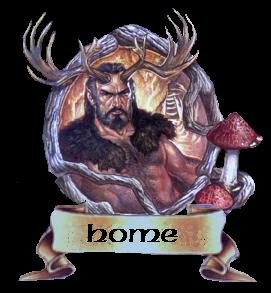Jonathon Earl Bowser - Used with permission
|
|||
April 30 Also known as: Mayday, Bealtinne (Caledonii), Festival of Tana (Strega), Walburga (Teutonic) May is the time of fertility and new beginnings after a long winter. The Faeries are afoot! They dance in the hills and roll in the grass, revelling in the joy of warm May breezes. Our spirits are high with the lust and heartiness of spring. New life is stirring and appetites are keen. -Laurie Cabot, Celebrate the Earth
In Celtic tradition, the two greatest festivals of the solar year are Samhain and Beltane, celebrations of death and rebirth, respectively. Love is in the air at Beltane. In our rituals, we celebrate the union between the Great Mother and her young Horned God. Their coupling brings fresh new life on Earth. Some form of this Great Rite is enacted on this sabbat in nearly every modern pagan circle. The Great Rite symbolizes the sacred marriage, or sexual union, of the Lord and Lady. Often the rite is performed symbolically by a male and female who place a knife (a phallic symbol) into a chalice (a female or yonic symbol). In Old Europe, whole villages would celebrate May Day by slipping away into the woods for indiscriminate sexual encounters. Any children conceived during this occasion were known as "merry-begots" and were considered children of the gods. These "greenwood marriages" were acts of sympathetic magick believed to have a positive effect on their crops, animals, and themselves. (In this age of Aids and other sexually transmitted diseases, however, we must exercise responsibility -- by means of safe sex, monogamy, or even abstinence. Use your better judgment.) Crop fertility was a strong theme at this sabbat. Besoms were ridden hobbyhorse-style through fields by women in symbolic fertility rites. Menstruating women ran and danced naked in the newly-sown fields. (Author Anonymous)
Ritual
The
altar and circle should be decorated with flowers. Any white flowers
are appropriate, especially those with five petals. The cauldron may be
filled with flowers. The altar cloth and candles shall be white. Flower
garlands may be worn by the participant. Set out your altar with your usual
tools. Include a white ribbon and a red ribbon. Light your incense and the
altar candles, and cast the circle. Invoke the God and the Goddess. Kneel
before the altar, facing East. Place the ribbons on the pentacle, the end of
the white ribbon covering the end of the red one. Speak these words: "Oh
Father God, oh Mother Goddess, now is the time of your joining.
Through your happiness, may all be happy, and through your
fruitfulness, may all in nature be fruitful." ~~o00o~~ Weaving and plaiting are traditional arts at this time of year, for the joining together of two substances to form a third is in the spirit of Beltaine. Foods traditionally come from the dairy, and dishes such as marigold custard and vanilla ice cream are fine. Oatmeal cakes are also appropriate. (excerpts from Scott Cunningham's Wicca: A Guide for the Solitary Practitioner) ~~o00o~~ |
|||
|
Beltane:
Its History and Modern Celebration in Wicca in America by
Rowan Moonstone The
celebration of May 1st, or Beltane as it is known in Wicca Circles, is one of
the most important festivals of our religious year. I will attempt here to
answer some of the most often asked questions about this holiday. An extensive
bibliography follows the article so that the interested reader can do further
research. 1.
Where does the festival of Beltane originate? Beltane,
as practiced by modern day Witches and Pagans, has its origins among the
Celtic peoples of Western Europe and the British Isles, particularly Ireland,
Scotland, and Wales.
2.
What does the word Beltane mean? Dr. Proinsias MacCana defines the word as follows: "... the Irish name for May Day is Beltane, of which the second element, `tene', is the word for fire, and the first, `bel', probably means `shining or brilliant'."(1) The festival was known by other names in other Celtic countries. Beltaine in Ireland, Bealtunn in Scotland, Shenn do Boaldyn on the Isle of Mann, and Galan Mae in Wales.(2)
3.
What was the significance of this holiday to the ancients? To the ancient Celts, it symbolized the coming of spring. It was the time of year when the crops began to sprout, the animals bore their young, and the people could begin to get out of the houses where they had been cooped up during the long dark cold winter months. Keep in mind that the people in those days had no electric lights or heat, and that the Celtic counties are at a much more northerly latitude than many of us are used to. At that latitude, spring comes much later, and winter lasts much longer than in most of the US. The coming of fair weather and longer daylight hours would be most welcome after a long cold and dark winter.
4.
How did the ancient Celts celebrate this festival? The most ancient way of observing this day is with fire. Beltane, along with Samhain (Nov. 1), Imbolc (Feb. 1), and Lughnassadh (Aug. 1), was one of the four great "fire festivals" which marked the turning points of the Celtic year. The most ancient records tell us that the people would extinguish all the hearth fires in the country and then relight them from the "need fires" lit by the druids (who used friction as a means of ignition). In many areas, the cattle were driven between two great bonfires to protect them from disease during the coming year. It is my personal belief, although I have no documentation to back up the assumption, that certain herbs would have been burnt in the fires, thus producing smoke which would help destroy parasites which might make cattle and other livestock ill.
5.
In what other ways was this festival celebrated? One of the most beautiful customs associated with this festival was "bringing in the May." The young people of the villages and towns would go out into the fields and forests at Midnight on April 30th and gather flowers with which to bedeck themselves, their families, and their homes. They would process back into the villages, stopping at each home to leave flowers, and to receive the best of food and drink that the home had to offer. This custom is somewhat similar to "trick or treat" at Samhain and was very significant to the ancients. John Williamson, in his study, The Oak King, the Holly King, and the Unicorn, writes, "These revellers were messengers of the renewal of vegetation, and they assumed the right to punish the niggardly, because avarice (as opposed to generosity) was dangerous to the community's hope for the abundance of nature. At an important time like the coming of summer, food, the substance of life must be ritually circulated generously within the community in order that the cosmic circuit of life's substance may be kept in motion (trees, flocks, harvests, etc.)."(3) These revellers would bless the fields and flocks of those who were generous and wish ill harvests on those who withheld their bounty.
6.
What about maypoles? The maypole was an adjunct to the festival of bringing in the May. It is a phallic symbol, and as such represented fertility to the participants in the festival. In olden days, the revelers who went into the woods would cut a tree and bring it into town, decking it with flowers and greenery and dance around it, clockwise (also called deosil, meaning "sun-wise", the direction of the sun's apparent travel across the face of the Earth) to bring fertility and good luck. The ribbons which we associate with the maypole today were a later addition.
7.
Why was fertility important? The people who originated this custom lived in close connection with the land. If the flocks and fields were fertile, they were able to eat; if there was famine or drought, they went hungry. It is hard for us today to relate to this concept, but to the ancients, it was literally a life and death matter. The Celts were a very close tribal people, and fertility of their women literally meant continuity of the tribe.
8. How is the maypole connected with fertility? Many scholars see the maypole as a phallic symbol. In this aspect, it is a very powerful symbol of the fertility of nature and spring.
9.
How did these ancient customs come down to us ? When Christianity came to the British Isles, many of the ancient holy sites were taken over by the new religion and converted to Christian sites. Many of the old Gods and Goddesses became Christian saints, and many of the customs were appropriated. Charles Squire says," An ingenious theory was invented after the introduction of Christianity, with the purpose of allowing such ancient rites to continue with a changed meaning. The passing of persons and cattle through flame or smoke was explained as a practice which interposed a magic protection between them and the powers of evil." (4) This is precisely what the original festival was intended to do; only the definition of "evil" had changed. These old customs continued to be practiced in many areas for centuries. "In Scotland in 1282, John, the priest in Inverkeithling, led the young girls of his parish in a phallic dance of decidedly obscene character during Easter week. For this, penance was laid upon him, but his punishment was not severe, and he was allowed to retain his benefice."(5)
10.
Were sacrifices practiced during this festival? Scholars are divided in their opinions of this. There is no surviving account of sacrifices in the legends and mythology which have come down to us. As these were originally set down on paper by Christian monks, one would think that if such a thing had been regularly practiced, the good brothers would most certainly have recorded it, if for no other reason than to make the pagans look more depraved. There are, however, some surviving folk customs which point to a person representing the gloom and ill fortune of winter being ostracized and forced to jump through the fires. Some scholars see this as a survival of ancient human sacrificial practices. The notion that animals were sacrificed during this time doesn't make sense from a practical standpoint. The animals which had been retained a breeding stock through the winter would either be lean and hungry from winter feed, or would be mothers nursing young, which could not be spared.
11.
How do modern day pagans observe this day? Modern day pagan observances of Beltane include the maypole dances, bringing in the May, and jumping the cauldron for fertility. Many couples wishing to conceive children will jump the cauldron together at this time. Fertility of imagination and other varieties of fertility are invoked along with sexual fertility. In Wiccan and other Pagan circles, this is a joyous day, full of laughter and good times.
12.
What about Walpurgisnacht? Is this the same thing as Beltane? Walpurgisnacht
comes from an Eastern European background, and has little in common with the
Celtic practices. I have not studied the folklore from that region and do not
consider myself qualified to write about it. As the vast majority of Wiccan
traditions today stem from Celtic roots, I have confined myself to research in
those areas.
|
.jpg)


